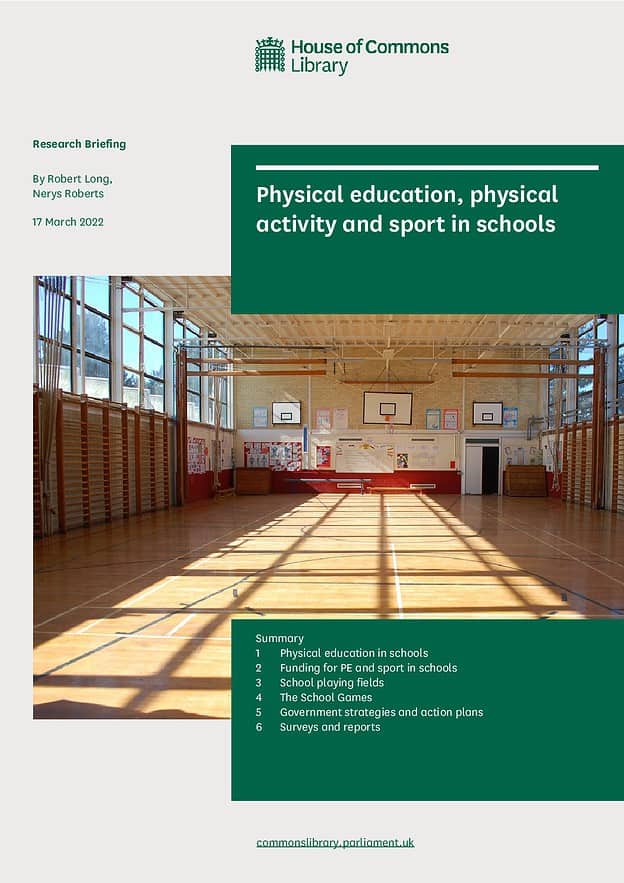PE is a compulsory subject under the National Curriculum at all key stages; National Curriculum programmes of study outline what should be taught at each key stage. Local authority maintained schools are required to follow the National Curriculum; academies and free schools do not have to follow it but are required to provide a broad and balanced curriculum that promotes the physical development of pupils.
Funding for PE and school sport
Funding for school PE and sport forms part of the Dedicated Schools Grant (DSG), which is not broken down by subject or curriculum area.
Since 2013-14, ring-fenced funding outside of DSG has also been provided to primary schools through the Primary PE and Sport Premium. From 2017-18, revenue from the soft drinks industry levy has been used to double the value of the premium from £160 million to £320 million. The Government has committed to providing the funding up to 2021/22.
In February 2017, the Government announced that £415 million of funding from the soft drinks industry levy would be allocated to schools in 2018-19 to “pay for facilities to support physical education, after-school activities and healthy eating.” The funding was referred to as the Healthy Schools Capital Programme. In July 2017, the then Education Secretary announced that the funding available for the Programme would be reduced from £415 million to £100 million to help fund an additional £1.3 billion for the core schools budget in 2018-19 and 2019-20. The £100 million was allocated through the existing arrangements for schools capital funding in 2018-19.
School playing fields
From October 2012, new regulations have applied to the provision of outdoor space by schools. These require that suitable outdoor space must be provided to enable “pupils to play outside” and “physical education to be provided to pupils in accordance with the school curriculum”.
Local authorities and schools must seek the consent of the Secretary of State when seeking to dispose of publicly funded school land, including playing fields. Guidance on the disposal of school playing fields, which was updated in March 2019, sets out the relevant legislation and procedure relating to the disposal of school land.
2015 Sport Strategy
In December 2015, the Government published a new sport strategy, Sporting Future: A New Strategy for an Active Nation. Regarding school sport, the strategy emphasised the importance of linking together the different stages of education and “more clearly join[ing] up the overall approach”. The strategy also contained a number of specific commitments relating to sport in schools.
School Sport Action Plan
In July 2019, the Government published a School Sport and Activity Action Plan. The Plan sets out an ambition that all children should have access to 60 minutes of physical activity every day, with at least 30 minutes taking place in schools and the remaining 30 minutes taking place outside school.
The Plan outlines a number of actions and commitments relevant to schools, including (but not limited to):
- In September 2020, the Government will launch a series of regional pilots to trial innovative approaches to increasing activity levels within and outside school.
- The Department for Education (DfE) will provide £500,000 to “test new approaches to improve the strategic direction and delivery of PE and school sport through the use of teaching schools.”
- Sport England will provide £1 million of National Lottery funding to develop a new digital resource for use in schools, to be launched in 2020, with the aim of empowering girls and building their confidence.
- The DfE will look at how to provide schools with a toolkit to support effective use of the PE and Sport Premium.
- The DfE will look at how Initial Teacher Training equips PE teachers to deliver high quality lessons.
The Government has stated it will publish an update to the Plan in 2022.
Data on children’s physical activity levels
In December 2021 Sport England published the latest set of data from its Active Lives Children and Young People Survey. The report summarised the activity levels of 5-16 year olds in England in the 2020/21 academic year.
Among other things, the survey estimated that around 45% of children and young people (3.2 million) achieved the new Chief Medical Officer guidelines of taking part in sport and physical activity for an average of 60 minutes or more a day. An estimated 32% did an average of less than 30 minutes per day. Activity levels were also found to vary by age, gender, family affluence, and ethnicity.



Responses